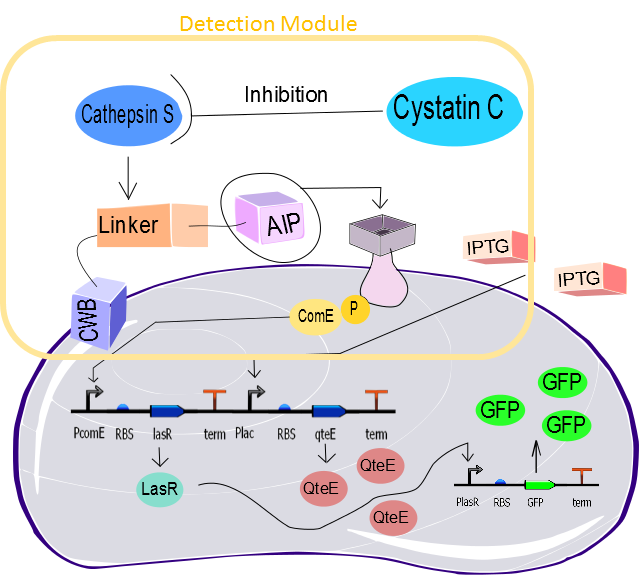Team:Brasil-SP/Project/DetectionModule
From 2014.igem.org
Detection Module
The genetic circuit that is being developed by the Brasil-SP team is a biodetection system designed for Cystatin C (Cys C). We will use the Quorum Sensing bacterial recognition system (QS), based on communication between bacteria. This system consists in the recognition and release of substances that diffuse through the environment; those substances are called autoinducers. The autoinducers are responsible for the activation of their own synthesis, allowing the bacterial cells to respond appropriately to cell population growth. Thus, it enables the control of specific genes expression, which are only activated when a certain cell population density is reached; as a result the bacteria behave coordinately (MILLER and BASSLER, 2001).
In our biosensor, the Quorum Sensing substance is called AIP and its receiver is called ComD. Both AIP and ComD are anchored in the cell membrane. The AIP is attached to a linker that can be cleaved specifically by the protease cathepsin S. After cleavage and release, the AIP binds to its receptor triggering the phosphorylation of ComE, an intracellular signalling molecule, which binds to a specific promoter initiating the expression of the downstream gene (lasR). The cathepsin S can have its proteolytic activity inhibited by Cys C, which would affect all the cascade described previously. Having said that, the Cys C concentrations will be detected through the variation of the cathepsin S protease activity, which ultimately causes regulates LasR production. In the Diagnosis section we describe how the bacteria will be capable of processing this information cariied by the LasR concentration to discriminate between normal and increased Cys C concentration.
Reference
- MILLER MB, BASSLER BL. Quorum sensing in bacteria. Annual Review of Microbiology , 2001, 55:165-99.
 "
"

